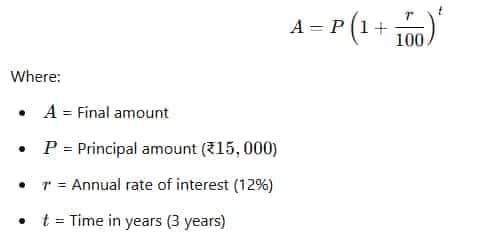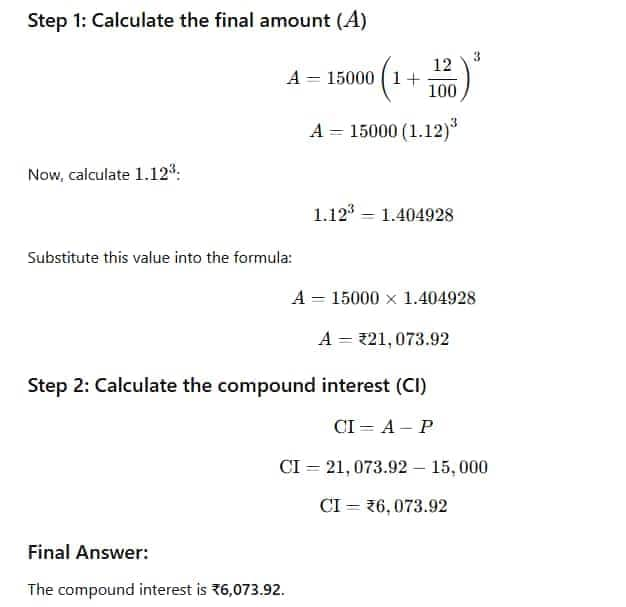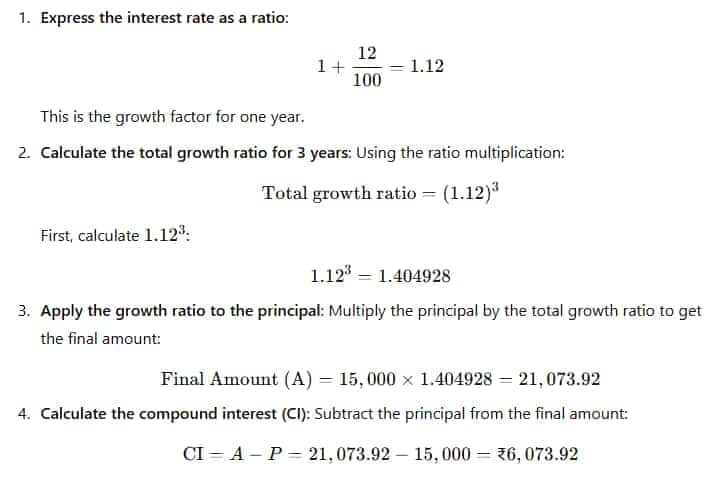UPES B.Des Admissions 2026
Ranked #45 amongst Universities in India by NIRF | Ranked #1 in Academic Reputation in India by QS World University Rankings
NID DAT Admit Card Date:11 Dec' 25 - 21 Dec' 25
Hello students! Important questions about simple and compound interest have previously been included in the NID DAT exam. Most applicants find it difficult to complete the tasks correctly and within the allocated time using a standard formula-based method because of their relative simplicity and upfront scoring. In an attempt to prepare candidates to answer the NID 2026 questions in a timely manner, this article compares the traditional formula-based approach with time-saving recommendations. The date for the National Institute of Design, NID 2026 is scheduled on December 21, 2025.
This Story also Contains

As per the revised selection process , the NID DAT 2026 prelims result will not have any weightage in the final selection of candidates for B.Des and M.Des programmes. The NID 2026 prelims exam will be a qualifying exam to shortlist candidates for the mains exam. NID Mains exam will have 60% weightage for studio test and 40% weightage for in person interview for NID B.Des selection.
According to the NID 2026 DAT Exam Syllabus, Students can prepare for Simple Interest and Compound Interest using the explanation and tips below:
Simple Interest: This is the method of calculating the interest on a given sum for a fixed rate of interest(R) on the Principal Amount(P) for a given duration of Time(T).
Formula For Simple Interest (S.I.) → [P X R X T] / 100
Compound Interest Formula (C.I.) →

Let’s try to understand the comparison for both through an example :
Calculating the Simple Interest S.I.: The Regular Formula Approach
Ques: Calculate the S.I. (Simple Interest) for 2 years on Rs 12000, calculated for a rate of Interest of 10% for the given duration.
Ans: Solving by using the S.I. Formula
P = 12,000
R = 10%
T = 2 years
By Formula S.I. = (PXRXT) / 100
= (12000X10X2) / 100
= Rs 240 (for Two Years)
Calculating the Simple Interest S.I.: The Fraction Trick
*Instead of working with the Percentage, convert the Rate of Interest (R%) to fractions for a faster mental calculation.
Example : R = 10% can also be written as R = (1/10)
The Interest is 1/10th of the Principal(P) for the first and second years, respectively.
Solving by using the “Fraction Trick” Formula
P = 12,000
R = 1/10 of P
Interest Earned = [(1/10) X Rs 12000] X 2 years
= 120 X 2 years
= Rs 240
Mostly, the Calculation could be done mentally using the “Fraction Trick for
Simple Interest ”.
You may also check:
EXAMS dates- 13-14 Dec | Leading Design College | Highest CTC: ₹12 LPA | Average CTC: ₹7.5 LPA | Scholarships for Deserving Students
Recruiters: Aditya Birla, Wildcraft, Tommy Hilfiger, Vero Moda etc | Only Fashion Institute in India to have entered the LIMCA BOOK OF RECORDS
Compound Interest: Compound interest is an extension of Simple Interest. Compound interest keeps on adding the interest generated in the principal amount. So, in compound interest is that the principal keeps on getting updated yearly.
Let's try to understand the faster approach for Compound Interest through a similar example:
Ques: Calculate the C.I. (Compound Interest) for 2 years on Rs 12000, calculated for a rate of Interest of 10% for the given duration.
Attempting the question through the Formula based approach :

Compound Interest = 12000 x [ 1 + (10/100)]2 - 12000
= 12000 x [ 1+.1]2 - 12000
= 12000 x [1.21] - 12000
= 14520 - 12000
= Rs 2520 approx. ( time consuming)
Calculating the Compound Interest with a Ratio Approach:
In this approach, we need to remember the table year-wise to calculate the compound interest for the desired number of years.
* Remember the table!
1 Year - 1
2 Years - 2: 1
3 Years - 3 : 3: 1
4 Years - 4: 6 : 4: 1
For the above example, where the interest is to be calculated for two years, the ratio :
Step 01: Calculate the Simple Interest for the first year, i.e. 10% of Rs 12000
= Rs 120
Step 02: Multiply the Interest in stages as shown with the given ratios
Interest @10% for Rs12000 in the first year = Rs 1200
If Calculating for 02 Years

Similarly, if we wish to calculate for three years (03), we need three steps.

This method is rapid and accurate for calculating the Compound Interest for any duration of Time (T = 1, 2, 3 years)
For Compound Interest, Interest is calculated based on both Principal and previously accumulated interest for previous years.
Mainly, questions are asked in DAT exams to calculate the interest for up to 4 years.
Compound interest Accumulates more Interest for the same duration than Simple Interest.
With Regular practice and memorizing the predefined set of values, aspirants can reduce the calculation time for the S.I. & C.I. based questions for NID DAT 2026.
Article students are advised to go through:
Aspiring students can prepare for Simple and Compound interest according to the NID DAT Exam pattern with the help of following tips:
Q: An amount of ₹15,000 is invested at an annual rate of 12% for 3 years. Find the CI using:
The traditional formula
Ratio Multiplication Technique
Solution:
To calculate compound interest (CI) using the traditional formula, we use:


To calculate compound interest (CI) using Ratio Multiplication Technique, we use:
Principal (P) = ₹15,000
Annual interest rate (r) = 12%
Time (t) = 3 years

Students preparing for the NID exam 2026 are advised to go through these important NID exam resources - free pdfs for download in order to better prepare for the exam:
NID Prelims Previous 5 Years Question Papers with Solutions (2021-2025) | |
NID DAT BDes Prelims Official Sample Paper with Detailed Solutions | |
NID DAT BDes 2026 Complete Guide PDF | |
NID Prelims Time Management |
Frequently Asked Questions (FAQs)
Students can use the fraction tricks as suggested in the article by replacing the percentage with the Fraction for faster calculations in the NID DAT 2026.
By practising the fractions method for simple interest and ratio method for compound interest, students can reduce the time for the questions.
It has been observed in the previous year question papers that questions on both topics were asked in the NID DAT Exam.
On Question asked by student community
Hello,
Yes, if you are in Class 12, you are eligible to sit for the NID DAT 2026 (BDes) exam. The National Institute of Design allows students who are in their final year of Class 12 or have already passed to apply.
To know more access below mentioned link:
https://design.careers360.com/articles/nid-admission-2026
Hope it helps.
You can get the NIT DAT SYLLABUS, updated version from careers 360 in detail from careers 360 article. Follow the link given from The link of the syllabus article is given below from careers 360
https://design.careers360.com/articles/nid-dat-syllabus-2026
Yes you are eligible to appear for NID DAT for the M.Des programme. Since you are in final make sure you will have completed your BA by the required deadline. Also go through the specific specializations you want to apply for, some may require certain specific backgrounds to be eligible to apply for them. You can find more details here design.careers360.com/articles/nid-dat-eligibility-criteria
Hello,
To prepare for M.des exams like CEED or NID DAT, here are some points which you can follow:
Understand the pattern – focus on creativity, design aptitude, and problem-solving.
Practice sketching daily and improve visualization.
Study basics of color, form, and design concepts.
Solve previous papers and build a strong portfolio.
Stay consistent and observe everyday designs for new ideas.
THANKU.
Hi daksh
As 563 rank in nid dat exam cannot guarantee admission in designing college but it could be a good chance to explore some campus as if you are not from general category as category role plays an important role . But now you can do one thing focus on your strengthening your protofile or preparing for the studio test (bdes) or interview (mdes).
Thanks.
Among top 100 Universities Globally in the Times Higher Education (THE) Interdisciplinary Science Rankings 2026
World-class design education with a global curricular collaboration with Parson’s School of Design
Ranked #45 amongst Universities in India by NIRF | Ranked #1 in Academic Reputation in India by QS World University Rankings
Ranked 2nd in the IIRF 2023 Design School Ranking | Approved by AICTE | Highest CTC 13 LPA
No. 1 Design & Fashion Institute by ASSOCHAM, India Today, Outlook and The Week rankings
EXAMS dates- 13-14 Dec | Leading Design College | Highest CTC: ₹12 LPA | Average CTC: ₹7.5 LPA | Scholarships for Deserving Students